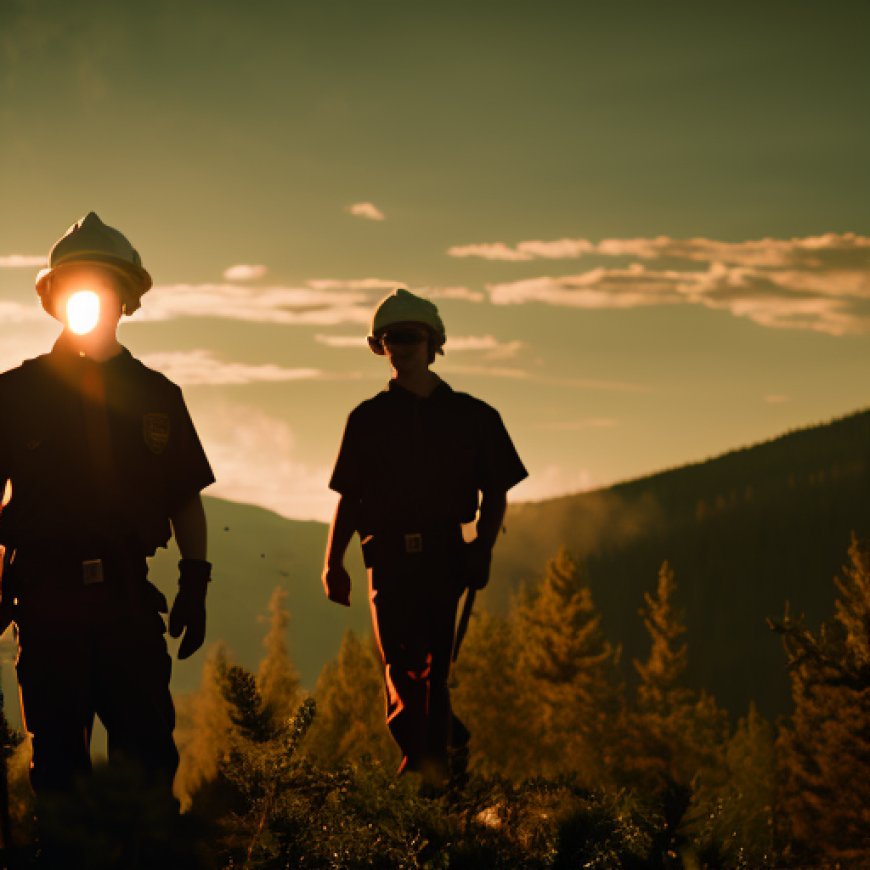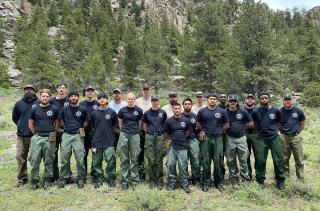Students of fire | US Forest Service
Students of fire | US Forest Service USDA Forest Service


Forest Service Job Corps Crews Support Wildland Fire Mitigation Efforts

Deep in a canyon in Colorado, six Forest Service trucks from Nebraska sit in the shade of a row of pines as firefighters pile brush nearby. A wildland fire crew from Nebraska’s Pine Ridge Job Corps is preparing for a prescribed burn while seasonal employees are being brought onboard.
“We’ve gone on five crew assignments already this season,” said Dayton Cleveland, supervisor for Nebraska’s Pine Ridge Job Corps’ Soldier Creek Wildland Fire Hand Crew. “This time of year, forests don’t have the employees, but we always have students ready to go. Before coming into this position, I didn’t realize how available Job Corps is for this.”
What is Job Corps?
Job Corps is the largest nationwide residential career training program in the country. The program helps eligible young people complete their high school education, trains them for meaningful careers, and assists them with obtaining employment, all at no cost. As part of the program, the Forest Service operates 24 Job Corps Civilian Conservation Centers. These centers combine the traditional Job Corps program with an opportunity to gain the skills required to conserve the nation’s natural resources. Most of these centers have a wildland fire crew. At any one time, Job Corps has the capacity to dispatch more than 1,000 firefighter-qualified students to support wildland fires, hazardous fuels reduction, and forest health programs nationwide, which has proved pivotal in confronting the nation’s wildfire crisis.
In January 2022, on the heels of some of the largest, most destructive fires in the nation’s history, the Forest Service implemented a 10-year strategy to address the wildfire crisis. Job Corps became a critical part of that effort, helping fill the demand for wildland fire crews to complete proactive fire mitigation work in the most at-risk landscapes.

Cleveland and his 20-person wildland fire crew were dispatched to help in the largest of those wildfire crisis landscapes, the Colorado Front Range, which includes the Arapaho-Roosevelt National Forests and Pawnee Grassland and the Pike-San Isabel National Forest. They’re the third Job Corps crew to come through the Roosevelt National Forest in 2023.
“Thanks to the Job Corps wildland fire crews that are helping out, we are accomplishing so much more this season than we would have on our own,” said Jason Sieg, deputy forest supervisor for the Arapaho and Roosevelt National Forests. “Bringing these crews out to local forests is also a great recruitment opportunity for us. It exposes people to national forests who may not have had that opportunity in their lives, and it opens their minds to a possible future Forest Service career.”
Careers in fire
Luke Hill, lead firefighter for Boxelder Job Corps out of South Dakota, just finished leading the crew through burn prep on the same Colorado Front Range project as Soldier Creek, but in 2013 he was studying brick m
SDGs, Targets, and Indicators in the Article
1. Which SDGs are addressed or connected to the issues highlighted in the article?
- SDG 4: Quality Education
- SDG 8: Decent Work and Economic Growth
- SDG 11: Sustainable Cities and Communities
- SDG 13: Climate Action
- SDG 15: Life on Land
2. What specific targets under those SDGs can be identified based on the article’s content?
- SDG 4.4: By 2030, substantially increase the number of youth and adults who have relevant skills, including technical and vocational skills, for employment, decent jobs, and entrepreneurship.
- SDG 8.5: By 2030, achieve full and productive employment and decent work for all women and men, including for young people and persons with disabilities, and equal pay for work of equal value.
- SDG 11.b: By 2020, substantially increase the number of cities and human settlements adopting and implementing integrated policies and plans towards inclusion, resource efficiency, mitigation and adaptation to climate change, resilience to disasters, and develop and implement, in line with the Sendai Framework for Disaster Risk Reduction 2015-2030, holistic disaster risk management at all levels.
- SDG 13.1: Strengthen resilience and adaptive capacity to climate-related hazards and natural disasters in all countries.
- SDG 15.2: By 2020, promote the implementation of sustainable management of all types of forests, halt deforestation, restore degraded forests, and substantially increase afforestation and reforestation globally.
3. Are there any indicators mentioned or implied in the article that can be used to measure progress towards the identified targets?
- Number of youth and adults with relevant skills for employment and decent jobs.
- Employment rates for young people and persons with disabilities.
- Number of cities and human settlements implementing integrated policies and plans for climate change mitigation and adaptation.
- Resilience and adaptive capacity to climate-related hazards and natural disasters.
- Extent of sustainable management of forests, deforestation rates, and afforestation/reforestation efforts.
Table: SDGs, Targets, and Indicators
| SDGs | Targets | Indicators |
|---|---|---|
| SDG 4: Quality Education | 4.4: By 2030, substantially increase the number of youth and adults who have relevant skills, including technical and vocational skills, for employment, decent jobs, and entrepreneurship. | Number of youth and adults with relevant skills for employment and decent jobs. |
| SDG 8: Decent Work and Economic Growth | 8.5: By 2030, achieve full and productive employment and decent work for all women and men, including for young people and persons with disabilities, and equal pay for work of equal value. | Employment rates for young people and persons with disabilities. |
| SDG 11: Sustainable Cities and Communities | 11.b: By 2020, substantially increase the number of cities and human settlements adopting and implementing integrated policies and plans towards inclusion, resource efficiency, mitigation and adaptation to climate change, resilience to disasters, and develop and implement, in line with the Sendai Framework for Disaster Risk Reduction 2015-2030, holistic disaster risk management at all levels. | Number of cities and human settlements implementing integrated policies and plans for climate change mitigation and adaptation. |
| SDG 13: Climate Action | 13.1: Strengthen resilience and adaptive capacity to climate-related hazards and natural disasters in all countries. | Resilience and adaptive capacity to climate-related hazards and natural disasters. |
| SDG 15: Life on Land | 15.2: By 2020, promote the implementation of sustainable management of all types of forests, halt deforestation, restore degraded forests, and substantially increase afforestation and reforestation globally. | Extent of sustainable management of forests, deforestation rates, and afforestation/reforestation efforts. |
Behold! This splendid article springs forth from the wellspring of knowledge, shaped by a wondrous proprietary AI technology that delved into a vast ocean of data, illuminating the path towards the Sustainable Development Goals. Remember that all rights are reserved by SDG Investors LLC, empowering us to champion progress together.
Source: fs.usda.gov

Join us, as fellow seekers of change, on a transformative journey at https://sdgtalks.ai/welcome, where you can become a member and actively contribute to shaping a brighter future.







